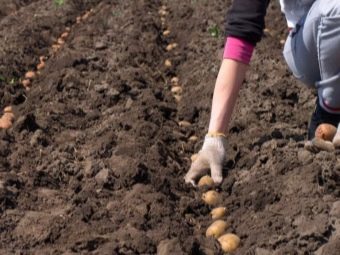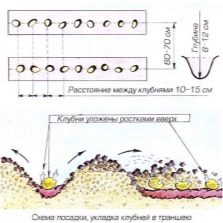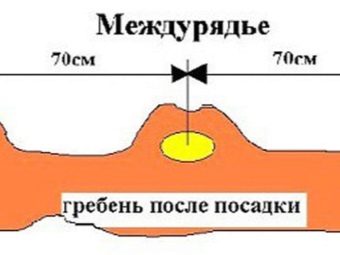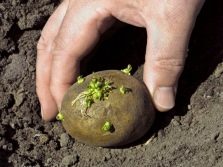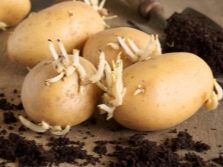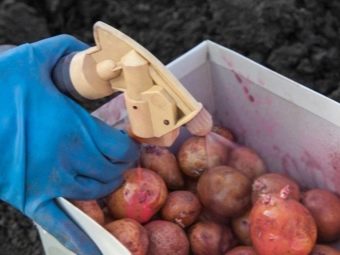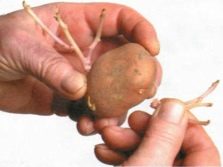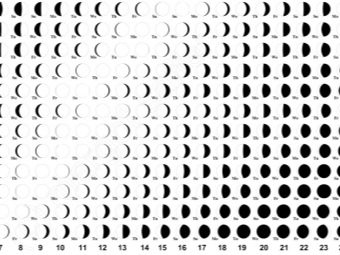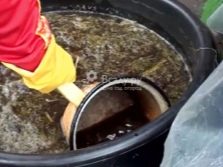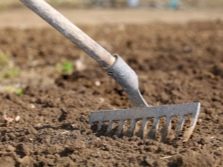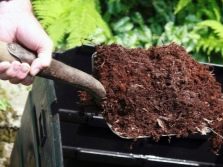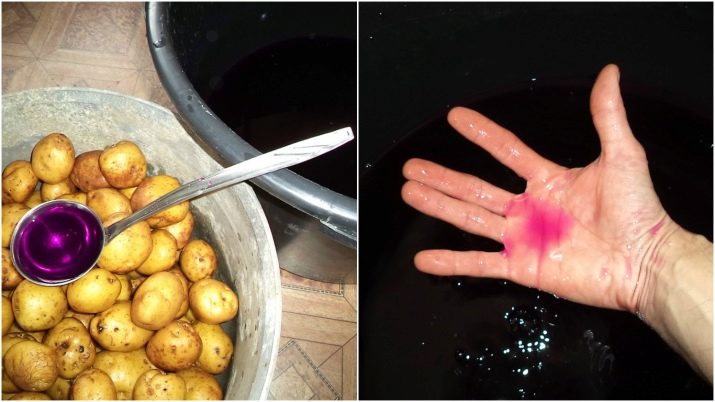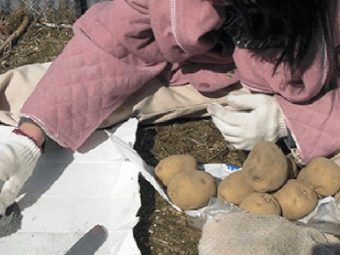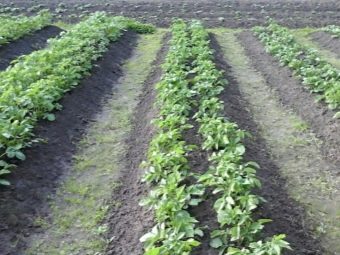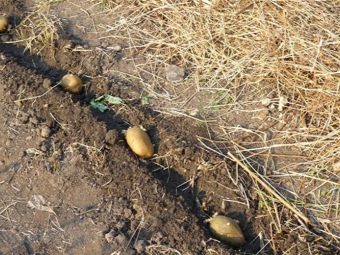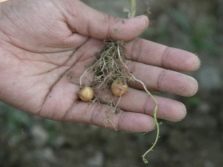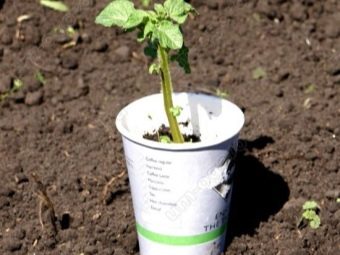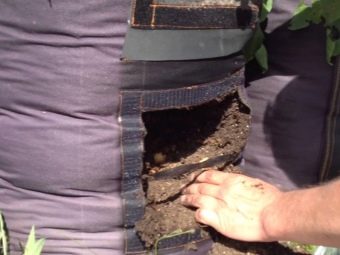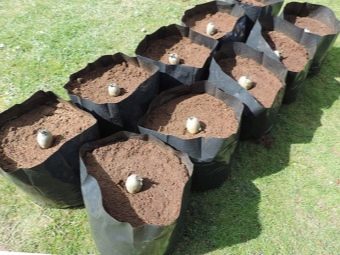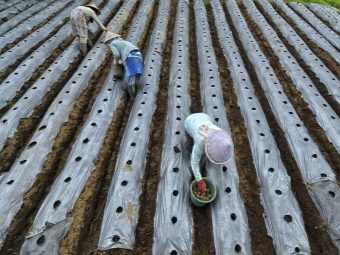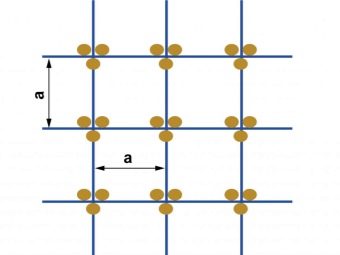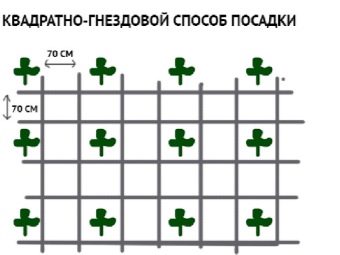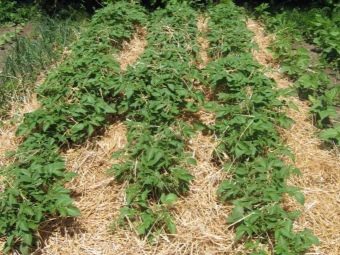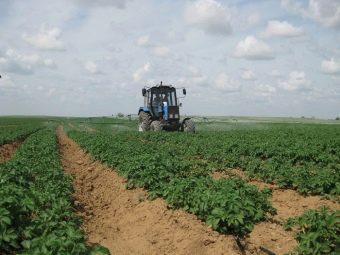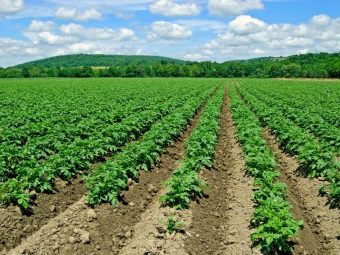Schemes and methods of planting potatoes
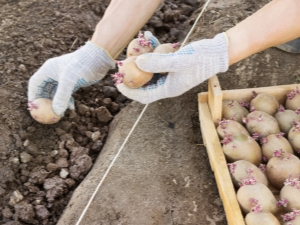
Properly planting potatoes is not an easy task even for a professional.In this case, there are many subtleties and nuances, including special schemes and methods of planting the root.
rules
There are certain rules for planting potatoes that you should know. All of them depend on the soil characteristics and climatic factors of a particular region where the planting is performed. In the northern regions, as well as in places where groundwater comes close to the surface of the earth, potatoes are planted mainly using the ridge method to a depth of at least ten centimeters. In areas where there is a lack of sufficient moisture, the usual method of planting is used, going deeper into the soil by 6-8 centimeters. In the Black Earth and other regions, the methods of planting potatoes combine.
The chemical composition and characteristics of the soil cover also play an important role. The softer the land and the warmer the climate, the more deeply the seed. In clay and loamy soils, they are planted on the surface. On sandy soils of the southern regions, the planting depth can increase to 14 centimeters.
For planting vegetables are generally accepted standards. The width between the rows should be at least 70 centimeters. With different methods, it may vary slightly. The distance between the landings should be 25-45 centimeters. (depending on the size of the seed). Between large tubers the distance increases, and between small ones, respectively, decreases.
Experts advise to adhere to such landing schemes:
- for aisle when planting later varieties - 70 centimeters; for the early 60 centimeters;
- intervals between root crops: for late varieties - 35 centimeters; for the early - 25 centimeters;
- planting depth when planting on heavy soils - 5 centimeters; on loamy soils - 10 centimeters, on light ground - 12 centimeters.
The distance between the rows directly depends on the number of eyes on the potato: the more there are, the thicker the plant will be. Hence, the distance between them can be increased.
When planting should take into account the features of the potato. For example, there are varieties adapted for growing in arid, humid and cold regions, as well as resistant to insects and various diseases. It is necessary to correctly calculate the growing season and favorable conditions for the growth of root crops. The flavor characteristics of each variety, whether it be a salad or mealy potato, with dense or loose pulp, are important.
Choose a seed
Seeds can be either tubers or seeds, you can also plant potatoes with potato stolons or cut particles with eyes. Special planting tubers are called sowing. They are all small in size. These tubers need about 260 pieces per hundred. Before planting, a set of preparatory measures should be carried out to enhance the growth and plant defense mechanisms. You can just put the fruits for a few days in a warm, dry room, or you can wash the roots in a manganese water solution and sprinkle with ashes.
There are also complex methods of preparation, in which the roots of several pieces are placed in plastic bags with holes for ventilation. Then they unfold in the light in the premises and periodically turn over on a wooden frame in order to provide access of light rays to the entire surface of the seed. As soon as the first shoots begin to erupt, the roots are transferred from the packages to the boxes with sawdust and constantly irrigated with water until the thread-like roots appear.
Before planting, potatoes with roots are well spilled with water and carefully, so as not to damage them, they are treated with insecticides and fungicides. The advantage of this method is the rapid germination and good yield without loss of material during culling.Potatoes prepared in this way ripen a couple of weeks earlier than usual.
Another method of preparation is made by using regrown stolons for planting. Germinated parts are detached from potatoes and dipped in a solution with a biostimulator. Then the shoots are planted to a depth of five centimeters at a distance of 15, in the aisle - 70 centimeters. Planting method stolons helps rational use of the landing space with the maximum benefit, and the yield at the same time increases several times.
In different climatic zones, potatoes are planted at different times, trying to follow the general rule: the planting layer of the soil should be at least +8 degrees. In the northern regions of the potato planted in late May. For this purpose, early and mid-season varieties are suitable. In the western regions and Transbaikalia potatoes are planted in early May. The earliest landings are made in the south of the country, in the Krasnodar Territory. Here, roots can be planted in the soil in April.
In accordance with the peculiarities of a particular region, it is necessary to choose the time and variety for planting. Need to navigate the varietal characteristics of fruiting. Thus, the early and early varieties ripen in two months; medium early for two and a half, and late harvest harvested four months from the time of planting. The phases of the moon undoubtedly have their influence on the development of plants, as well as other environmental factors, therefore, when planting, it is necessary to take into account that it is customary to plant potatoes on a waning moon, and on a full moon no planting work is performed.
Training
Potatoes need to be planted in a well prepared soil. He likes soft, non-acidic soils with plenty of light. Does not tolerate high temperatures and drought.
The preparation process is divided into several stages. First, plowing is done, the soil is prepared, then seed. Soil preparation consists of digging the ground and making additional fertilizing. Ridges for potatoes are prepared in the fall. Purified manure per three square meters of soil is applied to three buckets of organic matter. The fertilizer may also include ash and compost, and in some cases, added peat. Peat cushions should be placed on the landing site once every five years.
Before planting, the soil is fertilized with five kilograms of compost and water extract of onion peel with ash. The main thing you should pay attention to when preparing is loosening and supplying the soil with oxygen. Root grows well in soft soil, where the tubers can easily gain weight. Otherwise they may suffocate and the plant will die. In hard ground, roots become shallow and lose their taste.
At the stage of sorting, it is necessary to sort out the seed, separating the unsuitable tubers from the good ones. When culling, small, white and rotted tubers are removed, as well as root crops with signs of lesions and diseases. The best option is medium-sized tubers weighing no more than 80 grams each.
Clean planting material must undergo a decontamination step before it is lowered into the soil. For this, potatoes are placed in a solution of potassium permanganate or boric acid for 20 minutes. They also use complex solutions against microflora and pests that can be prepared by diluting 5 grams of boric acid, potassium permanganate (manganese) and copper sulphate in a bucket of water.
The effect of vitriol on young plants may be unfavorable, their growth may stop, so in some cases it is better to replace it with ordinary baking soda. All preventive measures can be in vain if the pathogens are in the root.
It is also necessary to process the tubers with mineral compositions and biostimulants.This procedure is necessary to improve growth and development, and also serves to strengthen the immune system, which, in turn, provides additional protection against harmful insects and various diseases. All actions are reduced to the fact that the selected tubers are alternately dipped in a solution of equal parts of ammonium nitrate and potassium salt, 40 grams per bucket of water. Then put the potatoes in polyethylene, so that it is well absorbed the composition, and dried well for an hour.
After this should be processed tubers amber acid. One pill of bioactivator is dissolved in a liter of water and potato tubers are processed with the resulting composition. Additionally, they can be powdered with wood ash before planting.
Methods
There are many methods of planting potatoes. All of them are made in different ways and each has its own pros and cons. The most common is by hand, using a spade. The method is extremely simple: digs are dug at a distance of 30, and in the aisle - 70 centimeters, into which potato tubers are dipped.
Landing in double rows is a cut parallel ridges, on the sides of which tubers are planted every 30 centimeters. The width of the knurling between rowers is 40 centimeters. Alternating planting promotes better development of the root system of potato bushes. In the process of vegetation, plants get more light and nutrients; they are easier to spud and water.
In regions with high humidity, soil is mainly used. planting potatoes on the ridges. The crests are cut using approximately 15 centimeters with a cultivator indented from each other. Potatoes are lowered to a depth of six centimeters and covered with a layer of soil. Hills provide the plant’s root system with the ability to breathe in conditions of high soil moisture. Rainwater simply drains from the mound, not lingering or stagnating in the root zone of the plant. But in arid time on loamy soils it is necessary to provide additional watering.
For areas with arid climate is characteristic planting potatoes in trenches. To do this, prepare the grooves in the fall. The depth of the trenches should be at least 30, in the aisle - about 70 centimeters. Fertilizers mixed with soil are laid in the grooves. In the spring, trenches will be shallowed and will be no more than five centimeters deep. To prevent overheating, lateral drainage systems should be dug just before planting to drain excess water.
Growing potatoes from seeds is not easy, you need to be patient and have certain skills. For those who do it for the first time, you need to know that when planting seeds you need to carefully prepare the soil, providing favorable conditions for the growth of root crops. It is good to use special containers for planting seeds. To use your own, not purchased seeds, you need to collect autumn bulbs - potato berries, dry them and get seeds.
In the first year of the harvest, there is no need to wait, the potatoes at the exit will represent seed material (sets) in the form of small potatoes of 20 grams each, suitable only for planting for the next season. This method is used to restore the purity of varieties, as through planting tubers varietal degeneration occurs due to the ability of root crops to accumulate information about diseases and other negative environmental factors.
The most convenient is way of planting through seedlings. This method can be applied at the cottage. Sowing is done in special containers - glasses in early spring. True, with the root system of potatoes, additional troubles may arise due to its slow germination. Therefore, it is advisable to first germinate the roots with a wet method in the boxes, and then plant them in the ground. In this case, the wells must be deep to accommodate the entire root system.Before the appearance of permanent leaves, seedlings should be covered with mulch or a special material such as agrofibre to protect the plant before heat is established.
For growing potatoes in the greenhouse or on the balcony is suitable planting method in pots, buckets, bags and any other suitable surface. Mobile containers for growing can be bought in a specialty store, and you can do it yourself. Some purchase options have pockets for getting ripe root crops. The advantage of this method is that the potato does not need hilling and vypalivanie, thereby facilitating the care of plants; they are easier to treat and feed, and bowls, bags and other containers can be put anywhere.
Land from landing later can be roasted and processed for reuse.
Planting potatoes also produced the method of landing layers. A plastic bag is taken with holes at the bottom, the edges of which are folded. A layer of drainage is laid at the bottom of the tank, sprinkled with well prepared soil from the compost in half with the ground. Then potatoes are planted there with eyes upward at a distance of just over ten centimeters from each other. A layer of earth is poured on the finished planting layer, and then the next layer of potatoes is laid.
Planting is done in a staggered manner so that the upper tubers are not directly below the lower ones. As the bush grows, the bag must be dismissed, and the earth should be poured at least a couple more times. 14 days after flowering, the potatoes reach ripeness, and the harvest can be harvested. This method of cultivation allows you to get up to three kilograms of root crops from the bush.
Putting potatoes in a bag can be different. There is also a side way of growing potatoes in greenhouse conditions. To do this, take a bag with the prepared soil and put it on its side. Then, on its surface, cross-shaped holes are cut, where the sprouted potatoes are planted.
With Chinese method of planting potatoes Mulching is done in early spring: the beds are covered with dark material or a film to protect against weeds and light. This method provides microcirculation of water and prevents the loss of moisture. On the surface, cuts are made into which they land in a staggered manner every quarter of a meter to a depth of about 10-15 centimeters.
According to this method, it is also possible to stretch the frame under the film in the form of a support made of bent metal rods. This cover has a greenhouse effect and protects the seedlings from freezing and adverse weather events. Having perforated, it is important not to allow adverse temperature shocks.
To protect the plant from overcooling, planting can be covered with elastic fiber, securing it around the perimeter. Growing bushes will lift the cover and will be able to develop unhindered.
The principle of growing potatoes by the method of Metlider is a favorable ratio of small 45-cm beds and wider - meter spacing. Due to this, the lighting area of bushes increases and potatoes grow faster and better, having enough space for the formation of root crops. This method is considered to be one of the most fruitful, it is simple and does not require hilling and loosening. The main advantage of it is that it is suitable for almost all climatic zones with different types of soil.
The disadvantages of the method are that it is not effective for swampy and stagnant places; When planting, a large amount of fertilizer is required, which are transformed only in the sun, and in shady places they will accumulate in root crops in the form of nitrates and other harmful compounds.
When square-nested method Tubers are planted. Subsequently, special attention should be paid to watering and hilling the plants.Each bush should be pushed to the sides and sprinkled with soil with organic fertilizer, leaving only the leaves uncovered. This method was created to mechanize the process of growing potatoes and other vegetables.
The planting pattern forms squares formed by equal distances between rows and holes. For different varieties, the size will be different: squares with a side of 60 centimeters - for early varieties, 70 - for medium and 90 - for late varieties of potatoes. The rest of the planting is carried out according to the general rules: the tubers sink to a depth of 6 centimeters, only two or three tubers are placed in each well at a distance of at least 10 centimeters from each other.
The meaning of the method is that the plants are at a sufficient distance and do not lack resources, receive light, nutrition and moisture in proper quantities, which has a beneficial effect on the size and quantity of the crop. This method is not recommended for dry regions, since moisture loss occurs largely due to the local kronirovaniya bushes. To reduce water consumption during watering, square-nesting planting is mulched with straw, twigs, or mowed grass. Thus, it is possible to reduce the loss of moisture due to the condensation process and not to carry out weeding and loosening of the soil cover.
The peculiarity of potato cultivation by the Dutch method is planting tubers in trenches. The advantage of this technology is good aeration of the soil, which prevents the accumulation of moisture and the heating of the roots, as well as sufficient lighting. This method is used to plant early and mid-early Dutch potato varieties that produce good yields.
When planting by various methods, it should be borne in mind that a positive result is possible only with strict adherence to the rules of cultivation, as well as with an integrated approach and compliance with agricultural practices.
Tips
To get a good harvest of potatoes, you also need to effectively use modern technologies and the recommendations of specialists:
- Beds should be located from south to north to provide plants with a more efficient distribution of heat and light.
- It is necessary to choose a planting plan based on the chemical indicators of the soil and the growing conditions of a particular potato variety.
- It is possible to plant early vegetables in open ground in mid-April, when the earth is well prepared with humus and compost, and the top is covered with a layer of straw to preserve heat.
- The larger the planting material, the stronger and larger the plant will be. When planting, you can save material and space by cutting potato tubers into several pieces. Ordinary and germinated tubers are planted in fractions.
When planting potatoes in sliced parts, it is necessary to water the planting holes well.
- Cut slices of potatoes need to stand for about two days in a dark warm room until the periderm appears, and then can be planted in the ground. Cutting roots immediately before planting can trigger an increase in the incidence of the plant. If the tubers were cut long and in advance, they should be stored in a cool room with optimum humidity before planting in order to prevent drying.
- So that the cultivation of potatoes is successful, you should choose for planting so-called zoned varieties, adapted for growing in specific climatic conditions.
- Transplanting young potato bushes stimulates their development and has a beneficial effect on the quality and quantity of the crop. Therefore, experts advise to put in the ground pre-germinated potatoes.
- To grow potatoes at home, it should be remembered that the potato is a light-loving plant, therefore, shadow exposure should be avoided. It is also not recommended to plant it in the winter on the balconies and window sills, as in the absence of a full light bottom the root crop does not develop.
- To protect against the Colorado potato beetle and various diseases caused by weakened immunity, onion peels are buried next to potato bushes. It is an excellent fertilizer and has antiseptic properties.
It will also be useful to take into account the peculiarities of planting potatoes in some areas of the country. For example, in the Central Region and the Moscow Region, where the climate is mostly temperate, and during the warm season there is enough rainfall, the plant lacks time to develop. The lack of heat and light significantly reduces the growing season of potatoes, while accelerating the development of root crops. Therefore, in these conditions, such early and middle varieties as Ivory, Rassvet, Vega, Dolphin, Zabava, Arizona, Lakomka, Daisy, Radonezh and other
In the Chernozem region with a continental climate, potatoes are planted in April, since the rainy season ends and the dry season begins in late spring. The surface layer of the earth dries out and the plant needs abundant watering. In such conditions, medium-early varieties grow well: “Dina”, “Zekura”, “Ilinsky”, “Condor”, “Ryabinushka”, “Wizard”, “Fakel” and others.
Potatoes are one of the most unpretentious vegetable crops of the family of Solanaceae with stable fruiting. But a good harvest depends on the proper planting and care for the plant. Therefore, when planting you need to know all the properties and characteristics of the root, as well as take into account the basic rules and subtleties of the process.
The most effective ways of planting potatoes, see below in the video.


